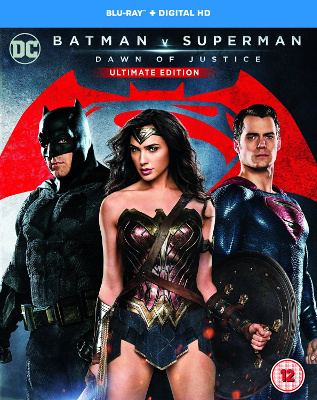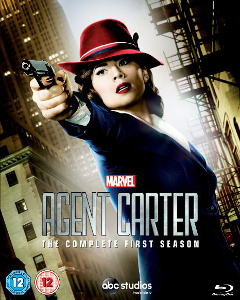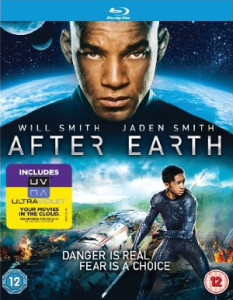 Genre: Children’s Fantasy / Film
Genre: Children’s Fantasy / Film
Main Creative Team: Paul King (director, writer, story); Hamish McColl (story); David Heyman (producer)
Main Cast: Ben Whishaw; Sally Hawkins; Hugh Bonneville; Madeleine Harris; Samuel Joslin; Julie Walters; Jim Broadbent; Nicole Kidman; Peter Capaldi; Tim Downie; Michael Gambon; Imelda Staunton
First Shown: 28th November, 2014
Available: Amazon.com | Amazon UK
The original Paddington Bear books, by Michael Bond (who has a cameo in the film), began publication in the late 1950s. The film isn’t a retelling of any specific book, but follows the same basic idea. Paddington’s (Ben Whishaw) home in Peru is destroyed, so he stows away on a ship heading for London. Once there, he ends up at Paddington Station, where he meets the Brown family. But things take a sinister turn when a taxidermist (Nicole Kidman) finds out he’s arrived.
I wasn’t sure how funny I’d find the film, as some of the humour stems from Paddington not understanding what’s going on and making mistakes. However, the funny side tended to be that things turned out unexpectedly, rather than Paddington feeling embarrassed or upset. I find the former funny, but the latter makes me uncomfortable. So I was glad it focused on unexpected resolutions.
The interactions between the Browns were great. At the start, there are obviously tensions in the family. Mr Brown (Hugh Bonneville) is very serious and obsessed with trying to shield everyone from risks. Judy (Madeleine Harris) sides with him over Paddington, because she wants the family to appear normal and not be embarrassing. On the other side, there’s Mrs Brown (Sally Hawkins), who is an artist, and Jonathan (Samuel Joslin), who dreams of being an astronaut. The dreamer side of the family want to help Paddington. I liked seeing how the family came together and sorted out their differences.
However, my favourite member of the family was Mrs Bird (Julie Walters), an elderly relative. Her asides, and her practical approach to dealing with Paddington, were very funny. She knows what’s really going on, even if it takes the Browns a little longer to figure it out.
There’s a magical realism feel to the film. Paddington causes some comment, but most people either ignore that he’s a bear or accept it after an initial comment. Things shift around the characters, such as the mural changing in the Brown’s house, the band playing the background music appearing in the scene, and the dolls house in the attic becoming a tiny version of the Brown’s house. This works particularly well due to the film being live action, as it grounds the surreal elements in the real.
One possible issue is whether people will make the connection between a bear in a children’s story and real refugees. I felt this was handled reasonably well, as there are references that reinforce this connection. Paddington has a label around his neck, reminiscent of child evacuees in World War II. This is stated directly in the film by his Aunt Lucy (Imelda Staunton), who hopes it will remind people of their past kindness. Putting this into the story was a nice touch, as it’s something the author of the books said was a direct inspiration for Paddington’s label.
Some of the hostility Paddington faces is based on fears about immigrants. The Brown’s neighbour, Mr Curry (Peter Capaldi), is worried that bears will end up taking over the neighbourhood and keep him awake with their jungle music. The narrative makes it very clear that Mr Curry isn’t a nice person. In contrast, Paddington also meets Mr Gruber (Jim Broadbent), who was a Jewish child refugee. Mr Gruber is warm, kind, and everything Mr Curry isn’t.
Colonialism is tackled in the tradition of snark and sarcasm. The film opens with an old colonial explorer (Tim Downie) on an expedition to Peru. He’s taken only the essentials, which means a trail of baggage including a large clock and a piano. Later, as the bears are learning English from a recording, it announces to them that British people have numerous words for rain, in a parody of the statements made about Inuit people and snow. Peru is referred to as Darkest Peru, as it is in the book, though the repetition of this is taken to an extreme that highlights its ridiculousness. Many of these moments are subtle, but clear in their critique of colonial attitudes.
The choice of villain also reinforces an anti-colonial narrative: she’s a taxidermist working at the Natural History Museum, who wants to return to a time when the best way to deal with a new species was to kill it and mount it as a trophy. She represents the old values, with all the problems that come with them. Her scenes are particularly chilling, because she is so callous about the value of life.
Though I generally liked the film, there were moments I didn’t like. There’s a scene where Mr Brown dresses as a woman as a disguise and a security guard flirts with him. These kinds of scenes rely on the idea that a man dressing as a woman is inherently funny, and that a man flirting with another man is funny. I did like some aspects of how it was handled though. Mr Brown later comments on the clothing being liberating. The disguise represents the first risk he takes to help Paddington, stepping outside of the constrictive life he’s constructed. It’s more unusual to follow up such scenes with a positive framing (it tends to be “never again, because I’m a manly man” rather than “actually, that was fine”).
I recognise that Paddington being called Paddington is unavoidable given the source, but it does still make me wince that he gets named because his name is deemed unpronounceable. That’s always been the part of the story that doesn’t sit well with me.
Paddington is a light-hearted family film with genuinely funny moments. I enjoyed seeing the Brown family come together and loved the visual style. The topic of refugees and immigration is as relevant now as ever, and the film presents this in a positive way. I would note some of the taxidermy scenes could be frightening for younger viewers. No animals are harmed, but the intentions are clear, and there are previously stuffed animals on show.
 Genre: Superhero / Film
Genre: Superhero / Film Alternate Titles: Zootopia
Alternate Titles: Zootopia Alternate Titles: Marvel’s Agent Carter
Alternate Titles: Marvel’s Agent Carter
 ** The review contains some mild spoilers, but not the major twists or ending **
** The review contains some mild spoilers, but not the major twists or ending **